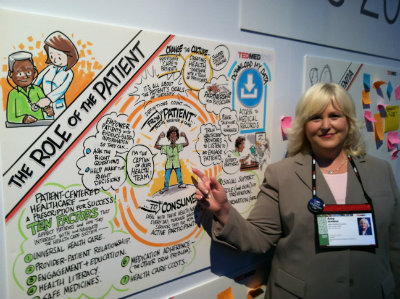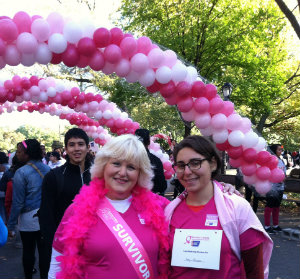 Amy Berman speaks at TEDMED's Great Challenges in Health Care in 2013.
Amy Berman speaks at TEDMED's Great Challenges in Health Care in 2013.Editor's Note: In this post, originally published on Health Affairs Blog, Amy Berman shares more of her story as a person living with stage IV cancer who has chosen a palliative care approach.
She contributes regularly to Health AGEnda about her experiences and how they relate to the John A. Hartford Foundation’s support for palliative care for older adults facing serious illness. In March 2014, the Hartford Foundation awarded a new grant to the Center to Advance Palliative Care (CAPC) to build on the successful spread of hospital-based palliative care and move these services into care settings outside the hospital.
Almost four years ago I was diagnosed with terminal cancer. And yet, as devastating as the diagnosis was, I have a great story to share, a success in every sense. I did something so simple yet so rarely done. I chose the road less taken, and it led to better health, better care, and significantly lower cost.
In October 2010 I was diagnosed with inflammatory breast cancer, a rare and incurable cancer. I saw the red spot on my right breast and immediately went to my doctor. Unfortunately, this type of cancer typically spreads before it appears on the skin. In my case it spread to my lower spine before it was ever noticed. I felt fine. I did everything right. But my prognosis was bleak and devastating; only 11-20 percent of people like me survive five years.
In April 2012 I wrote about my treatment decisions in the Narrative Matters section of Health Affairs, in the essay Living Life in My Own Way—and Dying That Way as Well.
Most people react to a cancer diagnosis with a familiar knee-jerk response. Get the cancer out. Opt for full-bore treatments such as chemotherapy and radiation. When one treatment fails, they search for another. Fight. Fight. Fight.
One oncologist suggested the full-bore approach to me: chemotherapy, mastectomy, radiation, and more chemotherapy. He suggested this knowing that the treatment wouldn’t help me live longer or better. It’s what he said he did for all his patients. Diane Meier describes one rationale behind these aggressive treatment decisions in the May issue of Health Affairs, in the essay ‘I Don’t Want Jenny To Think I’m Abandoning Her’: Views On Overtreatment” I wonder whether this first oncologist just didn’t want me to feel abandoned as Dr. Meier describes.
Dr. Meier, a renowned palliative care expert, offers a glimpse of the moral quandary providers face when patients are no longer likely to benefit from treatment. Some well-intentioned doctors don’t want their patients to feel they have given up on them. Thankfully, Dr. Meier created a dialogue with the oncologist and patient. In the end, the patient was fully informed. She did not have a catheter inserted into her brain for useless chemotherapy. And as she prepared for death, the patient thanked her oncologist for his excellent care.
Understanding Palliative Care
Palliative care is the best friend of the seriously ill. It helps people like me manage pain and symptoms and coordinate care. It helps address the spiritual needs of people and families. Palliative care helps people get through the effects of curative treatment. It helps people live better with chronic illness. And, at the end of life, palliative care supports the needs of the dying. Dr. Meier and palliative care physicians like her are my heroes.
Nearly four years ago I chose to be treated by another doctor, a superb oncologist who asked me what I hoped to achieve. Together, she and I chose those treatments that would help me hold on to the quality of my life. Yes, I take medication to try and hold the cancer at bay. But I opted against the typical throw-everything-at-it approach. No mastectomy. No radiation. Only one medication and not the typical noxious chemo cocktails. I chose to feel as well as possible for as long as possible.
I told my oncologist that I wanted the Niagara Falls trajectory. I wanted to feel good good good and then drop off the cliff. It’s the only way I know how to describe it. Unnecessary treatment is avoidable harm. Throwing curative care at incurable cancer amounts to a needless and debilitating assault on the body, as Dr. Meier describes.
A Ripple Effect
 A great life ... jet skiing to the Statue of Liberty.
A great life ... jet skiing to the Statue of Liberty.When I shared my story in Health Affairs, I had no idea what would come from it. I didn’t even know how long I would live. I didn’t know if I would get my Niagara Falls trajectory, after all.
Today, I feel great. The spot on my breast is no longer noticeable. On my most recent appointment the oncologist said that I have a “complete response.” That means they don’t see the cancer, not that it’s in remission. The cancer can take over at any time, but for now, it’s the best news. I’m confident my “less-is-more” treatment was the right treatment for me.
Life has been great. I am still working, harder than ever, I might add. I saw my daughter graduate from college. I climbed the Great Wall of China. I rode a jet ski to the Statue of Liberty and have the embarrassing photos in a wetsuit to prove it. And let me just add that, in addition to good care and good health, I have saved nearly a million dollars to date by choosing care that fit with my values and avoiding surgery, much more expensive and debilitating chemo, radiation, and hospitalizations. The palliative approach worked. I am a walking “triple aim”—better health, a better patient experience, and a lower cost of care.
Since I shared my story, I have seen significant changes in the policy and practice landscape. There is a growing awareness of this issue. The American Academy of Nursing sponsored a policy meeting and invited me to serve as a panelist. There were pieces about my story in the New York Times, Forbes, and mentions in Politico. I spoke at the Care Innovation Summit and TEDMED’s Great Challenges in Health Care.
I participated in Twitter chats that reached millions. And I wrote about my story for the John A. Hartford Foundation’s blog, Health AGEnda. My first blog, Can Good Care Lead to Bad Health?, led to a private meeting with then-Secretary of Health and Human Services Kathleen Sebelius and then-acting director of the Centers for Medicare and Medicaid Services Don Berwick.
Awareness turned into action. The Institute of Medicine (IOM) produced a seminal study, Delivering High Quality Cancer Care: Charting a New Course for a System in Crisis, for which I served as a reviewer and provided testimony.
The landmark report recommended that palliative care be initiated at the onset of serious illness. I gave a talk at the invitation of the National Institutes of Health advocating for increased attention to palliative care in the national research agenda, another IOM recommendation. The IOM report also spurred draft legislation in support of palliative care.
Palliative care is beginning to be integrated into the care of the seriously ill. The American Society of Clinical Oncology (ASCO) is launching a Palliative Care Virtual Learning Community, a new resource for oncologists. I serve on the advisory board for this effort.
Medical societies, led by the American Board of Internal Medicine, have banded together through the Choosing Wisely campaign. The campaign articulates those treatments that should be avoided by providers and the public because they do not offer value. My treatment fits within ASCO’s newly released Choosing Wisely guidelines for tests, procedures and treatments whose common use and clinical value are not supported by available evidence. I feel vindicated that the throw-everything-at-it approach suggested to me by one oncologist is now prominently considered poor care. I know I chose wisely.
For all the advances, we still have much to do to make the good care I receive broadly available. Palliative care is available and reimbursed in hospitals. But it is not reimbursed in community settings like home care and primary care. Graduate medical education still doesn’t pay for fellowship slots to train palliative care providers, who will become increasingly important as our country ages.
 Amy Berman, left, and her daughter Stephanie at the American Cancer Society's Making Strides event in New York's Central Park.
Amy Berman, left, and her daughter Stephanie at the American Cancer Society's Making Strides event in New York's Central Park.But perhaps the most troubling issue palliative care faces is the public misperception that palliative care means giving up. This couldn’t be further from the truth.
I had one very special gift come out of my Health Affairs piece: a letter written by a woman who had lost her mother to cancer a year before. The woman said she had battled depression for years, torn apart because her mother chose not to have the full-bore treatment for advanced cancer. She felt that she had failed because she was unable to convince her mother to take the chemotherapy.
But after reading my story, the woman reflected on her mother’s choice and their final days together. She and her mother spent time together, having fun, that they otherwise would not have had. For the first time, the woman wrote, she understood that her mother’s choice was to be with her. The gray cloud no longer hung over her. She was thankful.
I cried reading that letter, thinking of my own daughter. We talk about my choices. She says it’s a no-brainer.
Editor's Note: This is the latest in a series of Health AGEnda blog posts by Amy Berman chronicling her health and care since she was diagnosed with Stage IV inflammatory breast cancer. For earlier posts, please read:
Breast Cancer: Are We Making Strides?
Stunning New IOM Report Reframes How We View Cancer
Expecting Great Beginnings—and Endings
Transparency and the Teachable Moment
The Essential (Before I Kick the) Bucket List
Health Affairs Focuses on Cancer
Think Silver-Not Pink-for Breast Cancer Awareness Month
